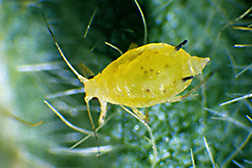This page has been archived and is being provided for reference purposes only. The page is no longer being updated, and therefore, links on the page may be invalid.
|
Read the magazine story to find out more. |
|
|
Soy Set to Withstand Exotic Aphid
By Jan SuszkiwNovember 7, 2005
A key genetic discovery by Agricultural Research Service (ARS) and university scientists opens the door to breeding soybeans that can resist Chinese soybean aphids.
Since first being detected in Wisconsin in 2000, the soybean aphid (Aphis glycines) has spread across the Midwest and into the Deep South, causing millions of dollars of losses to the legume crop. Growers have fought back with insecticide spraying, a practice that adds $12 to $25 per acre to their production costs.
ARS plant pathologist Glen Hartman and University of Illinois (UI) collaborators at Urbana have worked to find cheaper, longer-term alternatives. In early 2004, their efforts paid off with the discovery of Rag1, a single gene conferring resistance to the exotic aphid in two southern cultivars that are no longer grown.
Normally, the sap-sucking pest causes harm in the form of stunted growth, disfigured leaves, poor pod formation, and the plant's eventual death. But in tests, neither wingless female aphids nor their nymph offspring survived for long when confined to the resistant beans' leaves. Typically, 94 to 100 percent of female aphids died within 10 days--compared to 17 percent on “Pana,” a nonresistant variety--reports Hartman, at ARS' Soybean/Maize Germplasm, Pathology, and Genetics Research Unit in Urbana. Nymphs suffered a similar fate, he adds.
Hartman and UI collaborators Curtis Hill, Shawn Carlson, Brian Diers and Yan Li identified the aphid resistance after screening 800 commercial soybean cultivars and 3,000 germplasm accessions managed by ARS in Urbana. Since publishing their finding in Crop Science, the team has mapped Rag1's genetic whereabouts on the resistant beans' DNA (deoxyribonucleic acid). They've also identified marker regions and devised technology to detect them so that soybean breeders can rapidly identify resistant plants.
New, high-yielding cultivars bred to express Rag1 could be available by 2008. Meanwhile, the team's search for other resistance genes continues.
Read more about their work in the November 2005 issue of Agricultural Research magazine.
ARS is the U.S. Department of Agriculture's chief scientific research agency.

